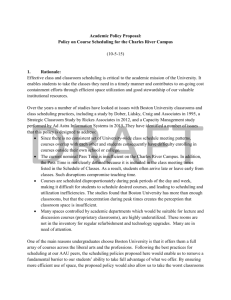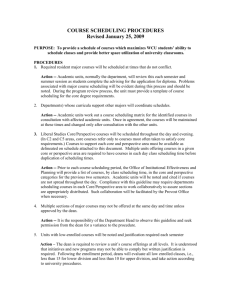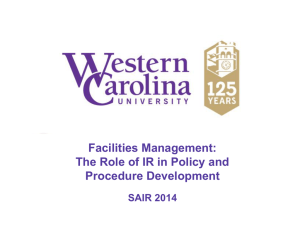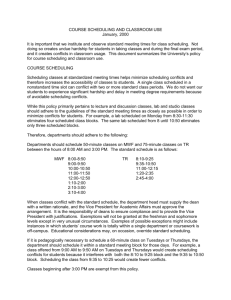Course Scheduling Guidelines 2012
advertisement
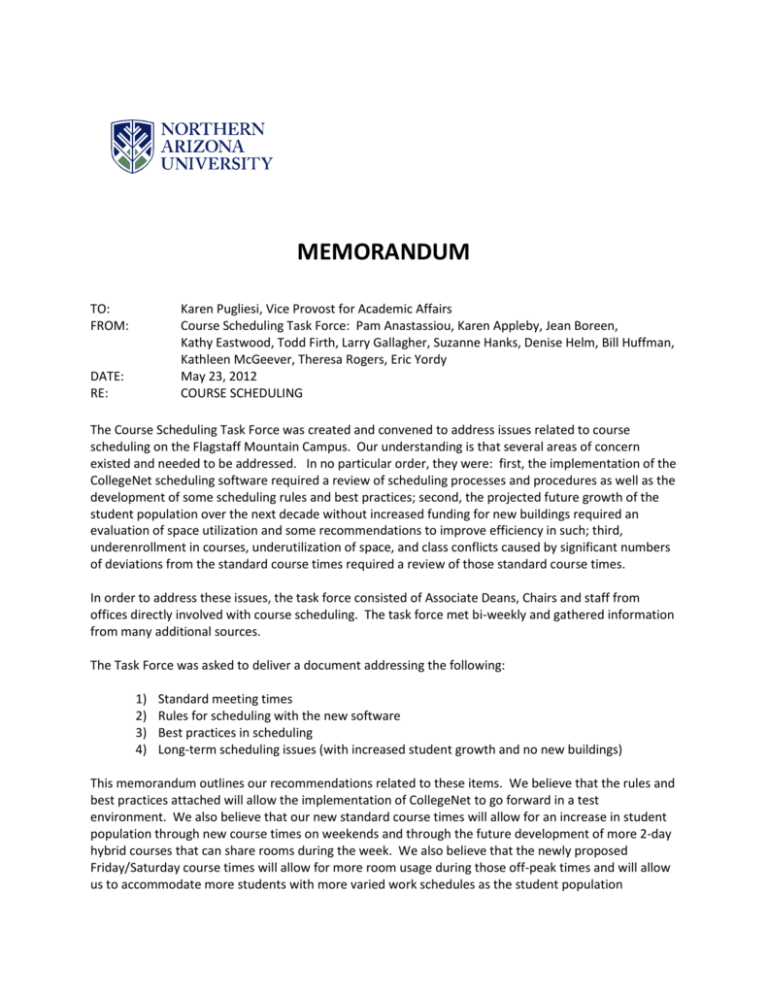
MEMORANDUM TO: FROM: Karen Pugliesi, Vice Provost for Academic Affairs Course Scheduling Task Force: Pam Anastassiou, Karen Appleby, Jean Boreen, Kathy Eastwood, Todd Firth, Larry Gallagher, Suzanne Hanks, Denise Helm, Bill Huffman, Kathleen McGeever, Theresa Rogers, Eric Yordy May 23, 2012 COURSE SCHEDULING DATE: RE: The Course Scheduling Task Force was created and convened to address issues related to course scheduling on the Flagstaff Mountain Campus. Our understanding is that several areas of concern existed and needed to be addressed. In no particular order, they were: first, the implementation of the CollegeNet scheduling software required a review of scheduling processes and procedures as well as the development of some scheduling rules and best practices; second, the projected future growth of the student population over the next decade without increased funding for new buildings required an evaluation of space utilization and some recommendations to improve efficiency in such; third, underenrollment in courses, underutilization of space, and class conflicts caused by significant numbers of deviations from the standard course times required a review of those standard course times. In order to address these issues, the task force consisted of Associate Deans, Chairs and staff from offices directly involved with course scheduling. The task force met bi-weekly and gathered information from many additional sources. The Task Force was asked to deliver a document addressing the following: 1) 2) 3) 4) Standard meeting times Rules for scheduling with the new software Best practices in scheduling Long-term scheduling issues (with increased student growth and no new buildings) This memorandum outlines our recommendations related to these items. We believe that the rules and best practices attached will allow the implementation of CollegeNet to go forward in a test environment. We also believe that our new standard course times will allow for an increase in student population through new course times on weekends and through the future development of more 2-day hybrid courses that can share rooms during the week. We also believe that the newly proposed Friday/Saturday course times will allow for more room usage during those off-peak times and will allow us to accommodate more students with more varied work schedules as the student population increases. While we believe that we have proposed an appropriate standard schedule, as well as appropriate rules and best practices for scheduling, the more efficient use of the space will ultimately depend on the ability and willingness of faculty to reconfigure courses to a hybrid model and the university’s ability to staff those classes equitably. Attached to this memorandum are several supporting documents. Appendix A contains our recommendations for new standard class times. To summarize, we are recommending that the university move to a common schedule on T/Th and M/W afternoons. We propose new class times for Friday afternoon and Saturday during the day. Our suggestion includes adding an additional set of 7-8 week courses at mid-term that would provide opportunities for students to keep moving towards academic progress even if they dropped a course earlier in the semester. This will allow students to add a course to maintain appropriate hours and/or maintain their degree progress. Appendix B contains our rules and best practices for scheduling. We approached this list with the intent that the rules would be programmable in the scheduling software while the best practices would not be programmable but would be followed by schedulers. Appendix C contains our revised version of a policy drafted by Vice President Burton related to scheduling of rooms. Issues not addressed Several issues were brought up during meetings but not addressed by the committee in our recommendations. These items should be addressed by the Provost’s office prior to implementation of a scheduling system. Funding, consistency and maintenance of technology With regard to maintenance of technology and facilities, it was unclear who will be responsible and how expenses will be handled. Given the potential for multiple departments to be using the same room, there is concern that the expenses of projectors, bulbs and other technology issues will not be fairly distributed. There currently are several thoughts on the issue: 1) centralize the technology maintenance funding – one fee for all students that will cover all technology maintenance (light bulbs in projectors, etc.). This has the benefit of being consistent for students. There are several concerns about how this might be implemented – maintenance must happen quickly and so the Work Order process may be too slow. This could be set up as a reimbursement pool of money where space managers continue to maintain the projectors and other technology but the funding comes from that central pool. This also will require looking at room-mediated fees and other course fees to ensure there is no “double charging” for the maintenance. Related to the double charging concern is the need to evaluate all fees at this point to separate a base fee that covers items common to all classrooms (projectors, bulbs, hardware) from items that are specific to certain courses (particular software for example). Other concerns include the need for development of technology replacement plans so that campus facilities are all kept current; 2) each space “manager” can maintain the space and implement a classroommediated fee to cover the particular technology of the room. This has the benefit of keeping the money where the maintenance will occur. The risk is that some courses may schedule the room without the fee attached to the course and the manager of the room would then be short on funds for maintenance. Scheduling non-academic rooms The Committee did not address the scheduling of non-academic rooms which may be needed or used for academic purposes. It is the opinion of this committee that spaces not designated as “academic spaces” be in control of the appropriate division (EMSA, Athletics. . .). If there is an academic need for a non-academic space, the academic division who needs the space may request it from the manager and should receive priority in the request because of the academic mission of the institution. If there is a consistent need for particular non-academic spaces by academic units, there should be a review of that space by the heads of the appropriate divisions to determine if that space should be reclassified as an academic space. Processes and procedures that impact course scheduling Concern was expressed that we need to work hard as a university to line up some of our processes and procedures. For example, if the classrooms will be open for reservations at some point, the academic units must have their schedule done at that point. Part of the delay in scheduling can be the funding of part-time faculty and one-year instructors. It is the recommendation of this committee that a group be pulled together to look at the standardization of this funding process as well as its timing to facilitate the use of the new scheduling system. The Committee would be happy to meet with you to discuss our findings and recommendations. APPENDIX A PROPOSED STANDARD MEETING TIMES UNITS WEEKS 15-Week courses 3 15 3 15 3 15 3 15 3 15 DAYS START END MWF MWF MWF MWF MWF 800 910 1020 1130 1240 850 1000 1110 1220 130 NOTES 3 3 3 15 15 15 TTH TTH TTH 800 935 1110 915 1050 1225 3 3 3 3 3 15 15 15 15 15 MW or TTH MW or TTH MW or TTH MW or TTH MW or TTH 1245 220 400 530 700 200 335 515 645 815 3 3 3 3 3 3 3 3 3 3 15 15 15 15 15 15 15 15 15 15 F F Any single night Any single night Any single night Any single night Any single night Any single night Any single night Any single night 1245 220 400 430 500 530 600 630 700 730 315 450 630 700 730 800 830 900 930 1000 800 850 910 1000 crosses over 2 periods on M/W or T/TH 1020 1130 1110 1220 crosses over 2 periods on M/W or T/TH 4 15 4 15 4 4 15 15 Any 4 day combination between M-F Any 4 day combination between M-F Any 4 day combination between M-F Any 4 day 4 15 4 15 4 15 4 15 3 15 3 15 3 15 7-Week Courses combination between M-F Any 4 day combination between M-F Any 4 day combination between M-F Any 4 day combination between M-F Any 4 day combination between M-F F/S F/S F/S 1240 130 150 240 crosses over 2 periods on M/W or T/TH 300 350 crosses over 2 periods on M/W or T/TH 410 500 crosses over 2 periods on M/W or T/TH FR start 1245 220 400 FR end 200 335 515 SAT start 935/1110 935/1110 935/1110 SAT end 1050/1225 1050/1225 1050/1225 3 7 F/S 100 430 900 1200 3 3 3 7 7 7 F F/S S 100 500 900 730 900 600 800 100 need 6.5 hours per week for 7 weeks could do 1-8 with a 30 minute break in the middle meets 5 times APPENDIX B Scheduling Rules 1. All rooms must be assigned an “manager” who controls the scheduling of the room. The manager typically will be labeled as a department instead of an individual. a. Some space will be designated Exempt Space - rooms designated for the use of a defined set of users, not available to others, located in areas generally not accessible and/or their purpose would be compromised by scheduling other uses. Examples include uniquely equipped rooms and rooms accessible only during limited hours. Specific schools and departments will retain jurisdiction and scheduling of such space. Exempt Spaces will not appear on the list of available rooms or will be marked as unavailable. Spaces will be designated Exempt Spaces by the Provost upon application by the managing unit. b. Some space will be designated Restricted Space - rooms which will appear on the list of available rooms but for which departments or schools will retain jurisdiction and scheduling control. These rooms are available for reservation but with restrictions (fees and/or rules, for example) which create the need for the managing unit to control scheduling and retain veto power over a proposed use. Spaces will be designated Restricted Spaces by the Provost upon application by the managing unit. 2. Some rooms may be set aside for the sole use of a department or college and are scheduled exclusively by the manager at all times. Typically these will be rooms that contain specialized equipment (cadavers, costumes, lab equipment). 3. From Phase I through Phase III of the Course Scheduling Process, spaces may only be reserved by the manager for courses and labs. a. Because of the lack of spaces for courses with expected enrollment of over 100 students, these courses may be scheduled during this phase by contacting the manager of the space. b. Department meetings for those departments needing classrooms for their meetings may be scheduled during this phase. c. Rehearsal times, open labs (and space for other similar curricular-required activities) may be scheduled during this phase. 4. At the beginning of Phase IV of the Course Scheduling Process, spaces may be reserved by the manager of the space for Academic-Related Activities for a period of two weeks. In addition, courses and labs from academic units that do not own space may reserve open classrooms during this two-week time period. “Academic-Related Activities” include supplemental instruction, academic student organizations, colloquia, student success initiatives and other similar uses directly tied to the academics of the unit. (We realize that ABOR primarily is interested in classes and labs offered between 8 am and 5 pm on weekdays, but we believe it is important to report and account for all usage.) 5. After the two week time period, requests from any college, department, or external entities will be scheduled on a first-come, first-served basis. The following priority list (from greatest priority to lowest priority) will be a general guide for conflict resolution. a. Classes and labs. b. Non-class/lab academic uses (i.e. supplemental instruction, tutoring, etc.). c. Academic-related extracurricular activities (student organizations with an academic purpose). d. Non-academic uses that serve the university’s mission. 6. A no-room designation is needed for such things as independent studies. Best Practices 1. Morning non-lab classes should always be offered at established NAU standard times. Exceptions to standard NAU times may be requested, but approval will be generally restricted to afternoon classes. Adjusting times in the mornings makes it very difficult for students to schedule their other classes. 2. The technology and equipment of a given room constitutes the priority on its use and scheduling priority. 3. Rooms should only be scheduled if the expected enrollment is at least 75% of the capacity of the classroom. The exception to this would be in the case of technology/equipment that is required for the course and not available elsewhere. 4. Departments should set capacity at the anticipated actual capacity for the classes when scheduling. For units that manage capacity to maintain even enrollment between sections (or for other reasons), the capacity on the classes should be lowered just before enrollment begins. This will avoid utilization concerns with the new software. 5. Departments and colleges should consider offering more classes later in the afternoon and through the early evening. 6. When possible, labs should either start or stop at standard NAU times. If only a few lab sections are needed, departments should consider offering them on T or Th rather than MWF. In this way a 2.5 hour lab will knock out only two class periods for a student rather than three. If many lab sections are needed, departments should work to maximize the utilization of their lab rooms, and to continue to work with departments whose students depend on those labs. Schedulers should offer the same lab at a variety of days and times during the week to ensure that all students will have a greater opportunity to enroll. 7. One-credit classes, such as recitations, should not be offered in the mornings because those one-hour classes may restrict a student’s opportunity to enroll in standard 3-credit courses. 8. When scheduling one-credit classes, schedulers can optimize the room use by scheduling a similar one-credit class at the same time on another day. For example, scheduling a recitation at 12:40 on Wednesday should entail scheduling recitations at that same time in that same room on Monday and Friday. 9. When possible, 4-credit classes should not be scheduled when they will cross over two different class periods. Some of the 4 x 50-minute slots prevent students from taking only one other course, while some slots prevent them from taking two other courses. 10. Synchronous or asynchronous hybrids should be scheduled in pairs or triplets, so that the inclass times will take up only one classroom spot in the standard meeting time schedule. Scheduling hybrids in this way can essentially double or triple the usage capacity of a room. 11. Some liberal studies classes (excluding lab sciences) should be scheduled for Friday afternoon/Saturday time periods. Ideally, these courses would be scheduled to start midsemester. This scheduling practice would allow students who have withdrawn from a class or entering the semester late to continue to make progress on their degrees as well as fulfill their financial aid requirements. 12. Because faculty members often need to speak with students both before and after scheduled class times, they should be scheduled for classrooms that are as close as possible to their office/home building. Reasons for scheduling classes at a distance from the office/home building include classroom size needs, technology needs or other legitimate pedagogical needs. Should a faculty member be scheduled at a distance from the office/home building, all care will be taken to ensure adequate travel time. APPENDIX C Room Scheduling Policy DRAFT Northern Arizona University (NAU) NAU Administrative Policy Statement Title: Scheduling Classroom/Lab Space Source: _______________________ Prepared by: _______________________ Approved by: _______________________ Effective Date: July 1, 2012 Replaces: Not Applicable Applies: Flagstaff Campus A. Introduction The purpose of this document is to set forth the policies and procedures regarding scheduling all academic spaces as identified on pages 32 and 84-89 of the 2010 NAU Flagstaff campus master plan or buildings or spaces not appearing in that plan that are designated as academic spaces. B. Policy Statement The Flagstaff campus strives to manage its classrooms/labs with a high degree of efficiency in keeping with the needs of its educational mission. Allocation of space is based on the criteria and procedures detailed in section E below. This policy conforms to the NAU Fiscal Policy for Use of Facilities and Equipment by Outside Parties or for Private Gain, which includes detailed criteria for use of space, fee-for-service charges, and other requirements for entities that are not part of NAU. C. Responsibilities Academic Affairs is responsible for maintaining accurate schedules for classrooms/labs and responding to requests in a timely manner. The Finance and Administration Office is responsible for maintaining an accurate inventory of spaces. Each unit responsible for scheduling a shared space must keep accurate and up-to-date information on the use of that space on the shared scheduling system. The president is ultimately responsible for all campus space. If there are any disagreements over the use of space, the president is the final authority for decision making. D. Definitions Academic Affairs – The Office of the Provost and designated employees within the Division of Academic Affairs. Campus- The Flagstaff campus. Classroom/Lab- A room designed and reserved primarily, but not solely, for teaching activities for credit courses. Exempt Spaces- Rooms designated for the use of a defined set of users, not available to others, located in areas generally not accessible and/or their purpose would be compromised by scheduling other uses. Examples include uniquely equipped rooms and rooms accessible only during limited hours. Specific schools and departments will retain jurisdiction and scheduling of such space. Exempt Spaces will not appear on the list of available rooms or will be marked as unavailable. Spaces will be designated Exempt Spaces by the Provost upon application by the managing unit. External Entity- Any private or public organization that is not part of Northern Arizona University. Restricted Spaces – Rooms which will appear on the list of available rooms but for which departments or schools will retain jurisdiction and scheduling control. These rooms are available for reservation but with restrictions (fees and/or rules, for example) which create the need for the managing unit to control scheduling and retain veto power over a proposed use. Spaces will be designated Restricted Spaces by the Provost upon application by the managing unit. E. Policy Procedures and Operational Details Academic Affairs will make every effort to manage space in conformance with this policy to efficiently balance the needs of multiple constituents with the limited space available on Campus. These procedures below will be in effect when conflict arises over classroom/lab space utilization. It may not be possible to approve all requests, and the following guidelines and procedures are designed to govern conflicting requests, while seeking greatest benefit, for the campus as a whole. 1. Principles for Scheduling Classroom/Lab Space As a general guideline, intended use of a space will be the first consideration in determining which room is assigned. The main factors are: unique technology class size and room capacity, or other characteristics of particular space. Classroom/Lab Space scheduling follows the schedule listed below. From Phase I through Phase III of the Course Scheduling Process, spaces may only be reserved by the manager for courses and labs. o Because of the lack of spaces for courses with expected enrollment of over 100 students, these courses may be scheduled during this phase by contacting the manager of the space. o Department meetings for those departments needing classrooms for their meetings may be scheduled during this phase. o Rehearsal times, open labs (and space for other similar curricular-required activities) may be scheduled during this phase. At the beginning of Phase IV of the Course Scheduling Process, spaces may be reserved by the manager of the space for academic-related activities for a period of two weeks. “Academicrelated activities” include supplemental instruction, academic student organizations, colloquia, student success initiatives and other similar uses directly tied to the academics of the unit. (We realize that ABOR primarily is interested in classes and labs offered between 8 am and 5 pm on weekdays, but we believe it is important to report and account for all usage.) After the two week time period, requests from any college, department, or external entities will be scheduled on a first-come, first-served basis. The following priority list (from greatest priority to lowest priority) will be a general guide for conflict resolution. o Classes and labs. o Non-class/lab academic uses (i.e. supplemental instruction, tutoring, etc.). o Academic-related extracurricular activities (student organizations with an academic purpose). o Non-academic uses that serve the university’s mission. Exempt Spaces and Restricted Spaces are under the sole control of the manager of that space. Reservations of those spaces are discretionary. Managers will comply with all local, state and federal laws in evaluating reservation requests. Conflicts should be resolved where possible between departments and through the Dean’s office of the space in dispute. Efforts will be made to provide consistency of assigned spaces for ongoing classes whenever possible. 2. Other policies regarding scheduling of classroom/lab spaces a. Access to rooms: The person/department requesting a room is responsible for making arrangements to access buildings and rooms before or after normal operating hours. If an event occurs during non-business hours, the person/department hosting the event must arrange access for participants. The Building Manager is the point of contact for access. The requestor is responsible for any charges related to access or special security requirements. b. Contracts and Insurance: Any event involving an external entity may require additional insurance and contracting through NAU Purchasing Services (928-523-6091). c. Parking: The requestor is responsible for contacting Parking and Shuttle Services in advance of any event to ensure necessary parking arrangements have been made. d. Ticketing: Any event for which admission is charged must follow comptroller policy CMP:306, which requires contracting and management by the NAU Central Ticketing Office (928-5235661). e. Food and Catering: Northern Arizona University Campus Dining has an exclusive contract for food service on the Flagstaff campus. Planners of events held on campus where food will be served must contract with NAU Campus Dining to provide the food. Events include, but are not limited to: catered events, residence hall activities, club activities, brunches, buffets, refreshment breaks, conferences etc. Food waiver applications may be obtained from NAU Dining website. If granted a food waiver delivery and clean up become the responsibility of the requestor not the building management or Academic Affairs. 3. Reporting on Space Utilization The Office of Planning and Institutional Research will report appropriate data as requested by the ABOR or others. 4. Policy Review and Revision This policy will be reviewed and modified, as necessary, each summer.

